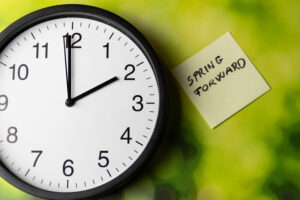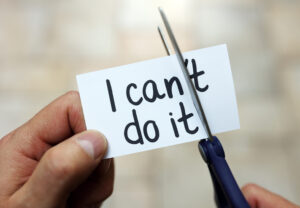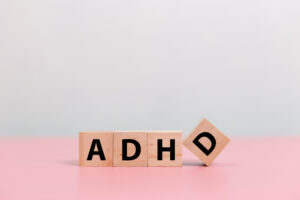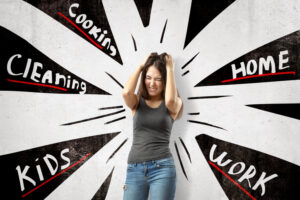Spring has sprung here on the East Coast, and I couldn’t be more happy! As soon as those clocks spring forward, something in me shifts. Perhaps it’s knowing that I won’t be in “hibernation mode” much longer, and will have warmer, longer days to be outside in the fresh air and sunlight. Or maybe it’s the sense of renewal and growth that seems more palpable at this time of year – it feels easier to access the motivation and energy that seemed lacking over the long Winter months. But when you are neurodivergent or have ADHD, this sense of seasonal optimism can also come with a side of seasonal disruption – to your mood, schedule, energy level, or appetite. There is a scientific connection between shifting seasons and ADHD symptoms, which can make it even more difficult to maintain focus and keep steady with routines. In this weeks blog, I’ll offer helpful strategies to survive the seasonal shift when you are neurodivergent or have ADHD.
days to be outside in the fresh air and sunlight. Or maybe it’s the sense of renewal and growth that seems more palpable at this time of year – it feels easier to access the motivation and energy that seemed lacking over the long Winter months. But when you are neurodivergent or have ADHD, this sense of seasonal optimism can also come with a side of seasonal disruption – to your mood, schedule, energy level, or appetite. There is a scientific connection between shifting seasons and ADHD symptoms, which can make it even more difficult to maintain focus and keep steady with routines. In this weeks blog, I’ll offer helpful strategies to survive the seasonal shift when you are neurodivergent or have ADHD.
ADHD & SEASONAL CHANGES
If you have ADHD, you’re probably no stranger to the ebb and flow of symptoms. Sometimes it feels like your attention span has a mind of its own – and unfortunately, that mind can be easily distracted. ADHD symptoms can fluctuate with the seasons, and spring brings some unique challenges. What is it about Spring and seasonal change that triggers this dysregulation? Let’s unpack the “why”, below:
Sleep Disruptions: As the days get longer, many people notice their sleep patterns changing. For those with ADHD, this can be even more pronounced. The increased daylight might mess with your circadian rhythm (the body’s internal clock), leading to difficulties falling asleep or staying asleep. According to a study published in JAMA Psychiatry, sleep disturbances are more common in individuals with ADHD, and these disruptions can worsen symptoms, making it even harder to focus during the day.
Energy Fluctuations: Spring can bring a burst of productive energy to some people, but for others, it can feel like unproductive, chaotic energy – the kind that’s difficult to harness. For individuals with ADHD, high energy levels can result in impulsivity, restlessness, or an inability to concentrate on tasks. On the flip side, the fluctuating energy levels in the spring may also leave you feeling drained on days when pollen counts are high or the weather is erratic.
Mood Changes: Seasonal changes can also affect your mood. As the weather warms up, people with ADHD might feel an increased sense of restlessness or irritability. Anxiety levels can rise, too, especially if you’re struggling with sleep disruptions or a lack of focus. In fact, research from the National Institute of Mental Health shows that anxiety disorders are often exacerbated by changes in routine, including seasonal shifts. The unpredictable nature of spring weather can heighten feelings of unease or uncertainty, making it even harder to stay grounded.
ANXIETY & THE SEASONAL SHIFT
Spring is also a time when people with anxiety may feel a heightened sense of unease. Just like with ADHD, changing routines and disruptions in sleep patterns can create a perfect storm for anxiety to thrive. Longer daylight hours may disrupt sleep cycles, and warmer temperatures can stir up social anxieties as people begin to spend more time outdoors or attend gatherings. If you’ve ever felt your heart race at the thought of a crowded spring festival or outdoor event, you’re not alone.

SPRING INTO FOCUS: STRATEGIES FOR COPING
Okay, now that we’ve painted the picture of the seasonal chaos, let’s talk about some ways to manage it all. After all, if spring is going to throw us curveballs, then we might as well have a bat!
- Adjust Your Sleep Routine: As daylight savings kicks in, it can be tricky to fall asleep on time. Try implementing a consistent bedtime routine – even on weekends – to help reset your circadian rhythm. And if you’re struggling with sleep, limit exposure to screens an hour before bed, and try using blackout curtains to keep the room dark in the early mornings.
Here are some good pre-sleep techniques to help engage your parasympathetic nervous system (the “rest and digest” system), which is your body’s natural way of saying, “Okay, chill. We’re done for the day.”
- Deep breathing exercises: Inhale for 4 seconds, hold for 4 seconds, exhale for 4 seconds, pause. Repeat three times.
- Guided meditation: Apps like Insight Timer, Headspace or Calm can guide you through short meditation sessions designed to relax your mind and body, though some are paid subscriptions. A quick google using the term “guided meditations for sleep” gives great (free) results to start from. Playing these before bed can also help you wind down.
- Progressive muscle relaxation: Start by tensing and then relaxing each muscle group, starting from your toes and working up to your head. Hold your breath for the muscle tension and exhale on the relaxation.
2. Get it done with GRIT: Those with ADHD find it especially difficult to get started and follow through on boring, unpleasant tasks – Spring is the perfect time to knock these out and get them done! My GRIT method is a process by which you get yourself ready to do a task or a work project, stay with it, apply consistent effort and finish a part or all of it.
get yourself ready to do a task or a work project, stay with it, apply consistent effort and finish a part or all of it.
To build motivation when you have ADHD, it is important to identify what you want to accomplish and why, and set goals accordingly. Then, once you’ve identified your goals, create realistic expectations of your capability, available resources and time constraints. Make a plan for when, where and how you’ll get things done. Try breaking large tasks down into smaller, more manageable pieces.
Then, use GRIT to make those everyday tasks less overwhelming:
G- Get Situated. Think about your tasks, do a brain dump and assign numbers to the first 3 items. Then, write where and when you want to do them. Break your first and second items down into smaller chunks. Finish these first two items before moving on to the next one.
R-Resist Distraction. Set reminders. Ask yourself, “How long can I do something before I get bored?” If it’s 20 minutes, do your tasks in 20 minutes. Write yourself a note marking where you left off. Go on your break, set the time, go back to what you were doing.
I- Implement incentives that matter. Start with small steps and identify achievable goals. Put the “have-to” before the “want-to,” and use incentives. Watch your TV show after you do the dinner dishes.
T-Take small steps & positively talk yourself through the task. Try a “high and a low,” or a “happy and a crappy” exercise at dinner to highlight the day’s wins. Consider writing down three good things or accomplishments each night before bed.
3. Get Outside: While spring beckons us outdoors, it’s important to listen to your own needs. If you’re feeling socially anxious or overwhelmed by too much stimulation, take a walk by yourself or spend time in a quieter outdoor space. Nature has been shown to have a calming effect, especially for those with anxiety, so try to embrace it in a way that supports your own wellness.
4. Exercise to Balance Your Energy: With ADHD, energy can feel like it’s running in all directions. Channel it into physical activity! Regular exercise can help stabilize mood and increase focus. Plus, it can work wonders for anxiety by releasing those feel-good endorphins. Whether it’s a brisk walk, a bike ride, or an online yoga class, moving your body can help ground you.
5. Use a Mood Tracker: If you notice your mood fluctuating with the changing seasons, try tracking it with an app or journal. Identifying patterns in your emotions can help you anticipate when you might feel more anxious or distracted, and allow you to plan accordingly. Awareness is half the battle!
The seasonal shift into spring is a time of change, but with that change comes an opportunity to refocus and rebalance. By adjusting our routines, embracing the outdoors (in our own way), and prioritizing sleep, we can turn the chaos of spring into a chance for growth. Just remember – be patient with yourself. ADHD and anxiety don’t go away just because the weather’s nice, but with a few tweaks, you can spring into focus and feel more grounded than ever.

 hold down a job and juggle personal responsibilities—all while trying to maintain a sense of balance. The executive functioning challenges that come with ADHD, in conjunction with hormonal influences, can make this all seem impossible to manage. So, Jessica, you are not alone. Working with women from all walks of life as they explore the impact of an
hold down a job and juggle personal responsibilities—all while trying to maintain a sense of balance. The executive functioning challenges that come with ADHD, in conjunction with hormonal influences, can make this all seem impossible to manage. So, Jessica, you are not alone. Working with women from all walks of life as they explore the impact of an  everyone’s appointments. It’s also meeting deadlines at work, showing up for meetings on time and being a dedicated team player. The emotional and psychological labor of these combined never-ending task lists can create significant burnout – especially when the person with ADHD has co-occurring anxiety.
everyone’s appointments. It’s also meeting deadlines at work, showing up for meetings on time and being a dedicated team player. The emotional and psychological labor of these combined never-ending task lists can create significant burnout – especially when the person with ADHD has co-occurring anxiety.  ADHD experience higher rates of anxiety and depression compared to their male counterparts. Many feel overwhelmed by the expectations placed on them—whether by society, family, or themselves. They also report feelings of guilt and shame about their challenges. The combination of external pressure and internal challenges can leave them feeling like they’re failing—often without recognizing that ADHD is a contributing factor.
ADHD experience higher rates of anxiety and depression compared to their male counterparts. Many feel overwhelmed by the expectations placed on them—whether by society, family, or themselves. They also report feelings of guilt and shame about their challenges. The combination of external pressure and internal challenges can leave them feeling like they’re failing—often without recognizing that ADHD is a contributing factor.
 executive functioning challenges related to planning and prioritizing, women with ADHD may face more significant barriers to accessing proper treatment and support, further exacerbating their health risks.
executive functioning challenges related to planning and prioritizing, women with ADHD may face more significant barriers to accessing proper treatment and support, further exacerbating their health risks.  research has shown that women with ADHD are more likely to experience co-occurring mental health conditions like depression and anxiety, which can further affect their overall health and well-being.
research has shown that women with ADHD are more likely to experience co-occurring mental health conditions like depression and anxiety, which can further affect their overall health and well-being.


 at once. Sometimes it’s hard to focus on just one thing because your mind’s flipping between all these different channels. It’s not that you’re not trying, but it’s just harder to concentrate.”
at once. Sometimes it’s hard to focus on just one thing because your mind’s flipping between all these different channels. It’s not that you’re not trying, but it’s just harder to concentrate.” explaining everything forever…and your daughter doesn’t want to always be on the receiving end of your explanations. Giving your teen the chance to attend these meetings also takes some of the burden off you in the future. It teaches her to speak up, ask for help when needed, and communicate her needs effectively. These skills will serve her well beyond high school, in her personal or professional pursuits.
explaining everything forever…and your daughter doesn’t want to always be on the receiving end of your explanations. Giving your teen the chance to attend these meetings also takes some of the burden off you in the future. It teaches her to speak up, ask for help when needed, and communicate her needs effectively. These skills will serve her well beyond high school, in her personal or professional pursuits. strategies designed to help people who struggle with big feelings manage them more effectively in real time. Sadly, there are no magic wands here—just practical, research-backed methods that support your well-being and help you handle whatever life throws your way.
strategies designed to help people who struggle with big feelings manage them more effectively in real time. Sadly, there are no magic wands here—just practical, research-backed methods that support your well-being and help you handle whatever life throws your way. aren’t aiming for perfection here. You will not transform suddenly into the ideal easygoing avatar you desire. But, When practiced regularly, grounding exercises train the brain to shift from knee-jerk reactions laden with emotional intensity to more balanced, thoughtful responses.
aren’t aiming for perfection here. You will not transform suddenly into the ideal easygoing avatar you desire. But, When practiced regularly, grounding exercises train the brain to shift from knee-jerk reactions laden with emotional intensity to more balanced, thoughtful responses. least two people you can contact when the going gets tough. For many people with ADHD, there’s so much shame about being dysregulated in the first place that it can be tough to ask for help. Remember,
least two people you can contact when the going gets tough. For many people with ADHD, there’s so much shame about being dysregulated in the first place that it can be tough to ask for help. Remember,  fencing, swimming, robotics or coding, art or rock climbing? Exploring new hobbies and engaging in them in a variety of formats shows your son that participating in a group activity doesn’t have to come at the expense of his self-esteem and that he can feel successful too. As he develops new skills, he’ll feel prouder of himself. This boost will strengthen his ability to deal with bullying too. He will also find a common ground to connect with like-minded peers who can be potential allies.
fencing, swimming, robotics or coding, art or rock climbing? Exploring new hobbies and engaging in them in a variety of formats shows your son that participating in a group activity doesn’t have to come at the expense of his self-esteem and that he can feel successful too. As he develops new skills, he’ll feel prouder of himself. This boost will strengthen his ability to deal with bullying too. He will also find a common ground to connect with like-minded peers who can be potential allies.  he can say something like, “It’s okay if we don’t agree on this” or “Everybody can have their own opinion.” Practice these at home in role-plays so you can see what the kids are saying and he can build confidence.
he can say something like, “It’s okay if we don’t agree on this” or “Everybody can have their own opinion.” Practice these at home in role-plays so you can see what the kids are saying and he can build confidence. 
 challenges: forgetfulness, overwhelm, difficulty focusing, and emotional ups and downs. All too often, there’s more stress than calm and more frustration than relaxation. How can you lower stress, increase happiness and improve your overall well-being? The answer may surprise you.
challenges: forgetfulness, overwhelm, difficulty focusing, and emotional ups and downs. All too often, there’s more stress than calm and more frustration than relaxation. How can you lower stress, increase happiness and improve your overall well-being? The answer may surprise you.  their ability to connect you to others. It’s this connection that allows you to feel good about yourself and build your self-worth. You are just being the best version of yourself–the part that is kind, loving and thoughtful. The part that doesn’t get enough air time when you are rushing to meet deadlines or pick the kids up from school and criticizing yourself along the way..
their ability to connect you to others. It’s this connection that allows you to feel good about yourself and build your self-worth. You are just being the best version of yourself–the part that is kind, loving and thoughtful. The part that doesn’t get enough air time when you are rushing to meet deadlines or pick the kids up from school and criticizing yourself along the way..  for
for  neurodivergent child, don’t forget to cut yourself some slack. Things won’t always go according to plan, and that’s okay. Sometimes, the most important things you can do are stay flexible, keep a sense of humor and ignite your playfulness. If you have to ditch caroling with the neighbors or throw unwrapped presents in colorful bags, that is just FINE.. After all, the holidays are about creating memories, not stressing over perfection.
neurodivergent child, don’t forget to cut yourself some slack. Things won’t always go according to plan, and that’s okay. Sometimes, the most important things you can do are stay flexible, keep a sense of humor and ignite your playfulness. If you have to ditch caroling with the neighbors or throw unwrapped presents in colorful bags, that is just FINE.. After all, the holidays are about creating memories, not stressing over perfection.